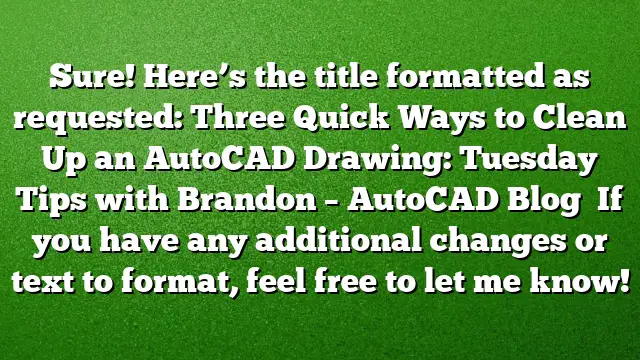Maximizing Efficiency: Cleaning Up AutoCAD Drawings
Creating an effective workspace in AutoCAD requires maintaining clean and organized drawings. A well-structured drawing not only reduces file size but also enhances collaboration, troubleshooting, and overall productivity. Here are three essential commands—Purge, Overkill, and Audit—that can help streamline your AutoCAD drawings efficiently.
Streamlining with the PURGE Command
Start your drawing cleanup process by utilizing the PURGE command, a fundamental tool for removing unnecessary elements from your workspace. This command is your primary strategy for achieving a cleaner, more manageable drawing.
-
Opening the Command: Type the command
Purgeinto the command line and press Enter. This will bring up the Purge dialog box. -
Reviewing Options: In the dialog box, you can review items available for purging, including unused layers, blocks, styles, and more. Pay attention to any nested items you might want to eliminate.
-
Making Selections: You can choose specific items to purge by clicking on them individually or opt for the “Purge All” option for a comprehensive cleanup in one action.
- Executing the Purge: After making your selections, confirm your choices. The drawing will instantly reflect a reduction in clutter and potentially a smaller file size.
Utilizing the OVERKILL Command
The OVERKILL command is a vital feature for resolving issues caused by overlapping and duplicate objects in your AutoCAD drawings. This command is crucial for decluttering without manually searching through your layers.
-
Launching the Command: Enter
OVERKILLinto the command line. -
Selecting Objects: Select the objects you wish to clean up. For a thorough approach, the
ALLcommand can be employed to choose every element in your drawing, keeping in mind that this may slow down performance with larger files. -
Adjusting Settings: A dialog box will appear, presenting options to filter which duplicates should be removed and the criteria used for selection.
- Finalizing Cleanup: After setting your preferences, click OK to execute the command. The system will remove unnecessary duplicates, enhancing drawing organization and potentially reducing file size.
Ensuring Integrity with the AUDIT Command
The AUDIT command is essential for ensuring the overall health and integrity of your AutoCAD files. It identifies and addresses errors, contributing to a more reliable drawing.
-
Initiating the Command: Type
AUDITin the command line and hit Enter. -
Fixing Errors: When prompted, agree to fix any errors detected during the audit by typing ‘Y’ for yes.
-
Reviewing Results: After completion, a report detailing errors found and fixed will display in the command line. An optional configuration allows you to create a text file (.ADT) that logs these errors. To enable this, set the AUDITCTL variable to 1 before running the AUDIT command.
- Locating the Report: The error log will be stored in your current drawing’s folder. You can open this file with Notepad or any basic text editor for review.
FAQ
1. How often should I use these commands?
It is advisable to incorporate these commands periodically—especially after significant changes or additions to your drawings—to maintain a clean and efficient workspace.
2. Can these commands be used in previous versions of AutoCAD?
Yes, while this article focuses on AutoCAD 2025, these commands are typically available in earlier versions as well, though some functionalities may vary.
3. What types of errors does the AUDIT command typically find?
The AUDIT command generally identifies and corrects issues related to object integrity, such as missing or corrupted objects, overlapping geometry, and other inconsistencies that could affect drawing performance.

